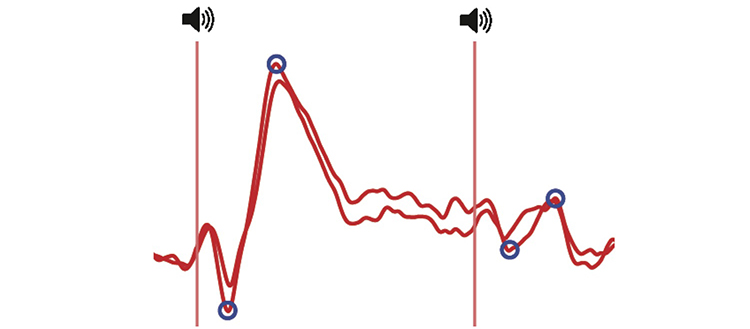Audition: How our brain filters sounds
Researchers at UNIGE have demonstrated that the brain adjusts the attention it gives to identical sounds as soon as they are perceived in the brainstem, a capacity that is lacking in schizophrenics.

Decreased brain response to the same repeated sound at an interval of half a second (left is sound 1, right is sound 2). Illustration: the responses recorded above the auditory areas of the cortex by means of electroencephalographic electrodes. © UNIGE
Our sound environment is extremely dense, which is why the brain has to adapt and implement filtering mechanisms that allow it to hold its attention on the most important elements and save energy. When two identical sounds are repeated quickly, one of these filters – called auditory sensory gating – drastically reduces the attention that the brain directs to the second sound it hears. In people with schizophrenia, this ability to reduce the brain’s response to identical sounds does not function properly. The brain, it seems, is constantly assailed by a multitude of auditory stimuli, which disrupt its attentional capacity. But the question is: Why? Neuroscientists from the University of Geneva (UNIGE), Switzerland, have been investigating the mechanism that lies behind this auditory sensory gating, which was previously unknown. Their results, published in the journal eNeuro, show that the filtering begins at the very beginning of the auditory stimuli processing, i. e. in the brainstem. This finding runs counter to earlier hypotheses, which held that it was a function of the frontal cortex control, which is heavily impacted in schizophrenics.
One of the main characteristics of schizophrenia, which affects 0.5% of the population, is a difficulty in prioritising and ranking surrounding sounds, which then assail the individual. This is why schizophrenia is diagnosed using a simple test: the P50. “The aim is to have the patient hear two identical sounds spaced 500 milliseconds apart. We then measure the brain activity in response to these two sounds using an external encephalogram,” explains Charles Quairiaux, a researcher in the Department of Basic Neurosciences in UNIGE’s Faculty of Medicine. “If brain activity decreases drastically when listening to the second sound, everything is okay. But if it’s almost identical, then that’s one of the best-known symptoms of schizophrenia.”
Although widely used to perform such diagnostics, the functioning of this filtering mechanism – called auditory sensory gating – is still a mystery. Most hypotheses held that this brain property is provided by a frontal cortex control, located at the front of the brain. “This area of control is badly affected in people suffering from schizophrenia, and it’s situated at the end of the brain’s sound processing pathway,” explains Dr Quairiaux, who worked on this research with Abbas Khani, a researcher in the Department of Clinical Neurosciences at the UNIGE Faculty of Medicine and the first author of the study.
The failure is situated at the base of sound processing
In order to test this hypothesis, the Geneva-based neuroscientists placed external electroencephalographic electrodes on mice, which were then subjected to the P50 test, varying the intervals between the two sounds from 125 milliseconds to 2 seconds. The results proved to be exactly the same as those observed in humans: there was a clear decrease in brain activity when listening to the second sound.
The scientists then placed internal electrodes in the cortical and subcortical auditory regions of the brain, from the brainstem to the frontal cortex – the pathway for processing sounds. The mice were given the P50 test a second time and, contrary to the initial hypothesis formulated by the scientists, the researchers observed that the drop in attention given to the second sound occurred already at the brainstem and not only at the cortical level, with a 60% decrease in brain activity. “This discovery means we’re going to have to reconsider our understanding of the mechanism, because it demonstrates that the filter effect begins at the very moment when the brain perceives the sound!” points out Dr Quairiaux. And where does this leave people suffering from schizophrenia?
“We’re currently carrying out the same study on mice with 22q11 deletion syndrome, a mutation that often leads to schizophrenia in humans, so we can see if the lack of a filter is situated in the brainstem, taking account of the new results we obtained,” continues the researcher. And that does indeed seem to be the case! The first tests on “schizophrenic” mice revealed the total absence of a filter for the second sound at the brain stem. The source of one of the most common symptoms of schizophrenia is about to be discovered.
